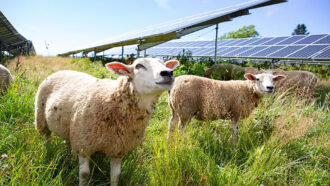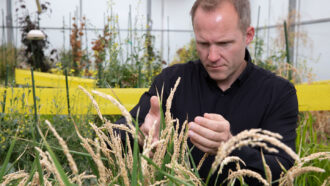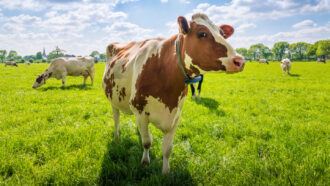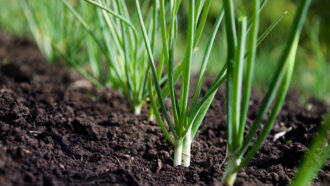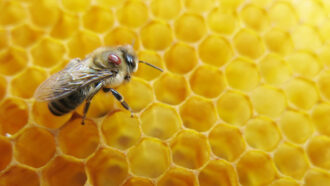Explainer: What is a gene bank?
Scientists have begun storing reproductive tissues — seeds or eggs and sperm — in banks around the world
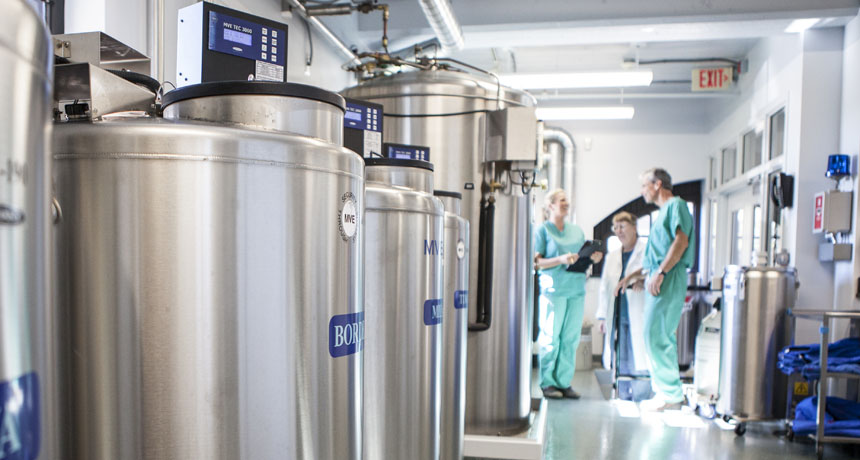
Deep-freeze tanks at the SVF Foundation’s campus at Newport, R.I., hold a wealth of genetic material from rare breeds of animals. “Banks” like this store genetic material in case it’s ever needed for research, for cross-breeding or to reduce inbreeding.
SVF Foundation
People save money in banks, in case of an emergency. Genetic banks serve a similar purpose for farmers and scientists who work to conserve rare plants and animals. Researchers or farmers can withdraw samples from these “gene” banks to help rebuild populations of rare plant varieties and animal breeds or to help increase genetic diversity within species.
Gene banks also preserve cells or organisms that host unusual gene variants — genes with special traits. Those genes might later prove useful when some disease epidemic strikes, when the climate changes or when other factors threaten the survival of plants or animals. Farmers could use the banked deposits — stored cells or tissues — to restore genetic diversity or to introduce traits from other breeds or varieties.
Some gene banks house millions or even billions of plant seeds. One example: the Svalbard Global Seed Vault. It’s located underground on a remote island north of Norway. The San Diego Institute for Conservation Research houses another project, called the Frozen Zoo. Its collection includes cells from thousands of birds, reptiles, mammals, amphibians and fish. The cells stored there might one day be used to help rebuild populations of endangered species.
The Smithsonian and SVF Biodiversity Preservation Project in the United States freezes semen and embryos from rare breeds of domestic animals. The U.S. Department of Agriculture’s Agricultural Research Service (ARS) has an even bigger program. It has almost a million samples of semen, blood and embryos from both common and rare breeds. Such collections serve “as a backup to the United States’ livestock industry,” explains Harvey Blackburn. He’s an animal geneticist. He also manages the National Animal Germplasm Preservation Program at an ARS lab in Fort Collins, Colo.
Gene banks use low temperatures to stop chemical and biological activity that might break down cells. Some banks freeze material in liquid nitrogen at –196° Celsius (-320.8° Fahrenheit). This freezing process replaces water in cells with another fluid, such as glycerol. That fluid minimizes the development of ice crystals. Such crystals could damage cell walls. Later, during thawing, biologists will remove the glycerol or some other fluid and return water to the cells.
Freezing and thawing cells has to be done quickly and carefully so that the material will still be viable after it has warmed back up. But some material requires extra special care.
The sperm from chickens and other poultry, for instance, do not survive the freezing and thawing cycle as well as does the sperm from cows and other mammals. Bird biology partially explains why, says Julie Long. A physiologist, she studies animal reproduction at an ARS lab in Beltsville, Md. Unlike female mammals, hens store sperm for several weeks after a single mating. Then they use those sperm over time to fertilize eggs. So thawed sperm must be very hardy to last such a long while in the female bird’s reproductive tract, she explains.
The shape of the frozen material also can affect how well it survives freezing. Bird sperm looks like a piece of string. That shape makes it more fragile than the sperm of most mammals, which contain a round head and slender tail. Ice crystals can more quickly damage DNA in a bird’s sperm.
But Long and other researchers are working to make the sperm of birds more resilient. “Bird sperm seems to respond better to a very fast freeze,” such as a 200 °C drop in one minute, notes Long. That’s more than three times as fast as the freeze rate necessary to preserve the sperm of mammals.
The liquid in which the material is stored also is important. For example, freezing removes some chemicals from the membrane that surrounds the sperm cells from poultry. Those compounds had been important. They helped the sperm cell recognize an egg. Adding certain sugars and lipids to the solution in which bird sperm are stored may replace the lost chemicals, Long says. Altering the protective fluid and freezing solution also may improve a sperm cell’s survival — and fertility. Long’s team reported promising research with turkey sperm in December 2013 and again in June 2014 in the journal Cryobiology.
A gene bank can hold many different types of materials. There may be seeds that will grow into whole plants, or eggs and sperm that can be united to create an animal. Or there may be animal embryos, which can be implanted into surrogate mothers. Some gene banks store stem cells, which scientists may one day use to produce eggs and sperm. Banks can even store reproductive organs, such as ovaries and testes. After thawing, these organs can go into animals of other breeds or even other species. Later, when mature, these organs will produce sperm or eggs with the genes of the animal from which they had been harvested.
Gene banks are a backup for the future, but they’ve already proven useful. In 2004, for instance, SVF took a few frozen embryos from a rare breed, the Tennessee fainting goat, and implanted them into a more common Nubian goat. That work produced Chip, known as “Chocolate Chip” at birth. Chip proved that the process could work, and now he’s a sign of hope for rare breeds.
Power words
amphibians A group of animals that includes frogs, salamanders and caecilians. Amphibians have backbones and can breathe through their skin. Unlike reptiles, birds and mammals, unborn or unhatched amphibians do not develop in a special protective sac called an amniotic sac.
artificial insemination Process for putting semen into an female animal to get her pregnant. The practice makes it possible for the animals to reproduce sexually without having to be present in the same place at the same time.
breed (noun) Animals within the same species that are so genetically similar that they produce reliable and characteristic traits. German shepherds and dachshunds, for instance, are examples of dog breeds. (verb) To produce offspring through reproduction.
climate change Long-term, significant change in the climate of Earth. It can happen naturally or in response to human activities, including the burning of fossil fuels and clearing of forests.
conservation The act of preserving or protecting the natural environment.
cryo- A prefix meaning that something is really cold.
embryo The early stages of a developing vertebrate, or animal with a backbone, consisting of only one or a or a few cells. As an adjective, the term would be embryonic.
endangered An adjective used to describe species at risk of going extinct.
gene (adj. genetic) A segment of DNA that codes, or holds instructions, for producing a protein. Offspring inherit genes from their parents. Genes influence how an organism looks and behaves.
genetic diversity Variability of genes within a population.
genetic Having to do with chromosomes, DNA and the genes contained within DNA. The field of science dealing with these biological instructions is known as genetics. People who work in this field are geneticists.
germplasm An organism’s genetic resources.
glycerol A colorless, odorless, sticky syrup that can be used as an antifreezing agent.
mammal A warm-blooded animal distinguished by the possession of hair or fur, the secretion of milk by females for feeding the young, and (typically) the bearing of live young.
ovary The female reproductive gland that makes egg cells.
physiology The branch of biology that deals with the everyday functions of living organisms and how their parts function.
population A group of individuals from the same species that lives in the same area.
reptile Cold-blooded vertebrate animals, whose skin is covered with scales or horny plates. Snakes, turtles, lizards and alligators are all reptiles.
semen Produced by the male testes in animals, it is a whitish fluid that contains sperm, which are the reproductive cells that fertilize eggs.
species A group of similar organisms capable of producing offspring that can survive and reproduce.
sperm In animals, the male reproductive cells that can fuse with an egg of its species to create a new organism.
surrogate A substitute; something that stands in or takes the place of another.
testis (plural: testes) The organ in the males of many animal species that makes sperm, the reproductive cells that fertilize eggs. This organ also is the primary site that makes testosterone, the primary male sex hormone.
trait In genetics, a quality or characteristic that can be inherited.
variant A version of something that may come in different forms. (in biology) Members of a species that possess some feature (size, coloration or lifespan, for example) that makes them distinct. (in genetics) A gene having a slight mutation that may have left its host species somewhat better adapted for its environment.
viable Alive and able to survive.


